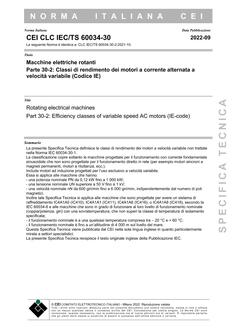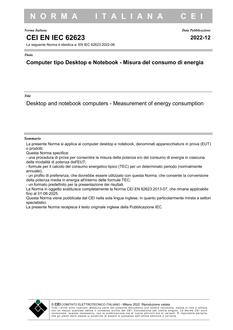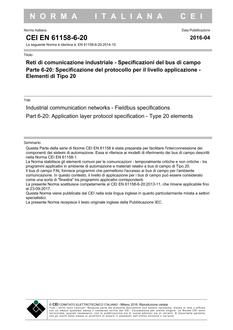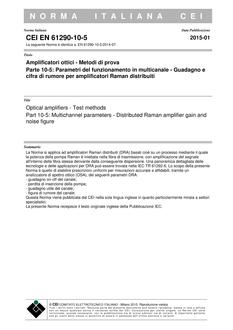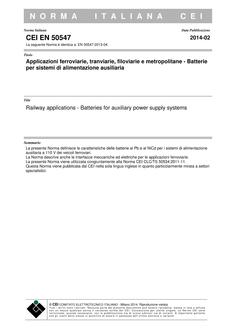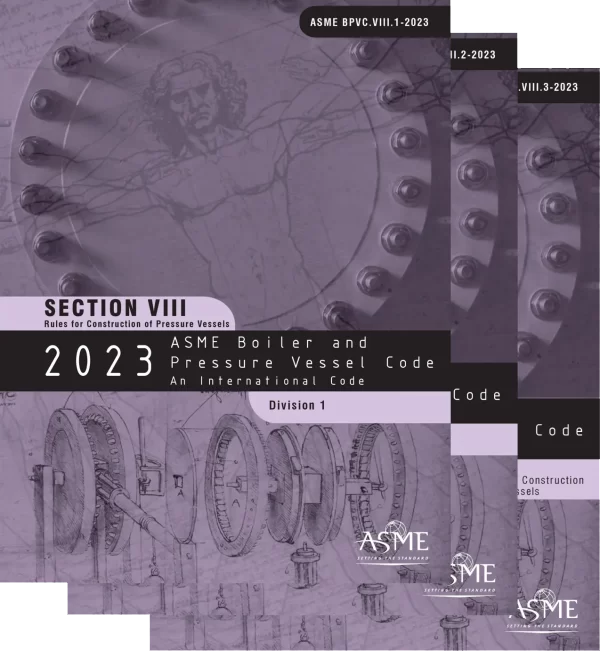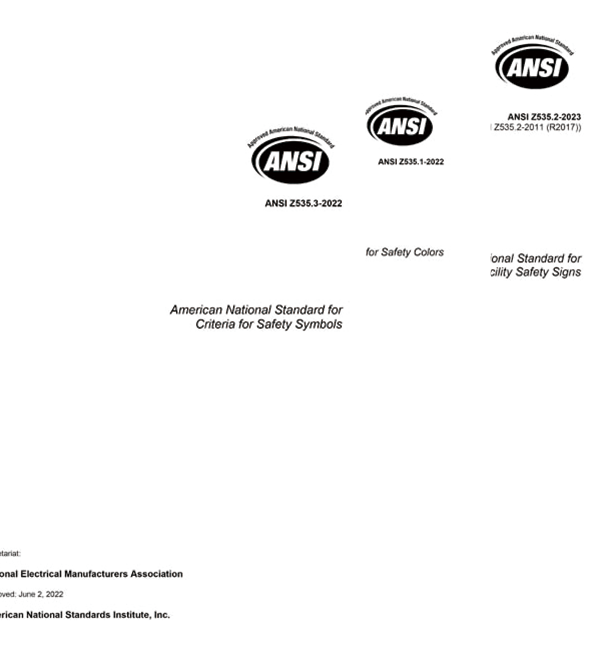CEI CLC IEC/TS 60034-30-2
2022
Rotating electrical machines Part 30-2: Efficiency classes of variable speed AC motors (IE-code)
- Format:
- Language(s) :
- Published :
- English
- 09/01/2022
ENGLISH
This part of IEC 60034, which is a technical specification, specifies efficiency classes for variable speed rotating electric machines not covered in IEC 60034-30-1.
The document only applies to machines that:
• have a rated power PN from 0,12 kW to 1 000 kW;
• have a rated voltage UN above 50 V up to 1 kV;
• have a rated speed nN from 600 1/min up to 6 000 1/min regardless of the number of magnetic poles;
• are designed for cooling methods IC4A1A0 (IC410), IC4A1A1 (IC411), IC4A1A6 (IC416), or IC4A1A8 (IC418) according to IEC 60034-6;
• are capable of continuous operation at their rated operating point (torque/power, speed) with a temperature rise within the specified insulation temperature class;
NOTE 1 Most motors covered by this document are rated for duty type S1 (continuous duty). However, some motors that are rated for other duty cycles are still capable of continuous operation at their rated power and these motors are also covered. Motors rated between S3 and S10 with a cycle time of 80 % or more may be included.
• are rated for any ambient temperature within the range of – 20 °C to + 60 °C;
NOTE 2 The rated efficiency and efficiency classes are based on 25 °C ambient temperature according to IEC 60034-2-1 and IEC TS 60034-2-3.
NOTE 3 Motors rated for temperatures outside the range – 20 °C and + 60 °C are considered to be of special construction and are consequently excluded from this document.
NOTE 4 Smoke extraction motors with a temperature class of up to and including 400 °C are covered by this document.
• are rated for an operating altitude up to 4 000 m above sea level.
NOTE 5 The rated efficiency and efficiency class are based on a rating for altitudes up to 1 000 m above sea level.
The classification only covers machines designed for operation with sinusoidal fundamental current that are not designed to be operated direct on-line (grid), for example permanent magnet synchronous machines with and without additional reluctance torque, sinusoidal reluctance synchronous machines and synchronous machines with DC field windings. This also includes induction machines that are designed exclusively for variable speed operation.
Switched reluctance synchronous machines are not covered.
The procedures to determine losses at any speed and load point are given in IEC TS 60034-2-3. They apply to all converter operated motors.
No distinction is made between motor technologies, supply voltage or motors with increased insulation even though these motor technologies may not all be capable of reaching the higher efficiency classes. This makes different motor technologies fully comparable with respect to their energy efficiency potential.
The efficiency of power-drive systems (i.e. the combined losses of motor and power supply) and the losses of the driven load are not covered by this document, see IEC 61800-9-2.
Covered in this document are also:
• Motors with flanges, feet and/or shafts with mechanical dimensions different from IEC 60072-1.
• Geared motors including those incorporating non-standard shafts and flanges. However, the testing of efficiency is to be performed on the motor part of a geared motor only.
• Motors specifically built for operation in explosive environments according to IEC 60079-0. Such motors may not be able to reach the higher efficiency classes (due to safety requirements and possible design constraints of explosion proof motors such as increased air-gap, reduced starting current, enhanced sealing).
Excluded from this document are:
• Motors with mechanical commutators;
• Motors completely integrated with the driven machine (for example pumps, fans and compressors) that cannot be practically tested separately from the machine even with provision of a temporary end-shield and drive-end bearing. This means that motors included in this document must:
a) share common components (apart from connectors such as bolts) with the driven unit (for example, a shaft or housing), and
b) not be designed in such a way as to enable the motor to be separated from the driven unit as an entire motor that can operate independently of the driven unit, When the process of separation renders the motor inoperative, it is excluded from this document.
NOTE 6 Some motors used in horizontal, inclined and vertical transport of goods and people are specifically designed for this purpose. They are often integrated into a machine and are not brought to the market as individual products. These motors are excluded.
• Brake motors when the brake is an integral part of the inner motor construction and can neither be removed nor supplied by a separate power source during the testing of motor efficiency.
Brake motors with a brake coil that is integrated into the flange of the motor are covered as long as it is possible to test motor efficiency without the losses of the brake (for example by dismantling the brake, removing the brake or by energizing the brake coil from a separate power source).
• Submersible motors specifically designed to operate wholly immersed in a liquid;
• Smoke extraction motors with a temperature class above 400 °C;
• Motors that are just soft-started with a frequency-converter and then operated on sinusoidal mains supply are rated according to IEC 60034-30-1;
• Motors that are designed for servo applications, i.e. applications where frequent overload or field-weakening operations or frequent speed or torque changes occur or no thermal steady state operation is reached.
NOTE 7 This document covers industrial motors which mostly run continuously at or near rated load, and whose speed is not changing often or rapidly. Such motors include those which drive compressors and conveyor belts, for example.
In order to achieve high efficiency at full load, magnetic flux densities within those motors are normally modest, often resulting in larger sizes and higher inertia rotors compared with standard efficiency machines.
On the other hand, motors for servo-drive applications, such as robot drives, machine tools and pick-and-place machines which experience frequent and rapid load and speed changes, often have low rotor inertia in order to achieve the required dynamic performance. Energy consumption in that case is mainly determined by the energy required for acceleration. Low inertia rotors tend to have higher losses in continuous operation, however.
Motors for servo-drives are therefore not covered by this IE-classification.
Motors excluded from this document may be evaluated as a power drive system (PDS) according to IEC 61800-9-2. In this case, the PDS which is composed of the motor and the frequency converter (CDM) is evaluated as IES0, IES1 or IES2.
| CEI CLC IEC/TS 60034-30-2 | |
|---|---|
| STANDARD INFO: | |
| Standard Name | CEI CLC IEC/TS 60034-30-2 |
| Scope | Rotating electrical machines Part 30-2: Efficiency classes of variable speed AC motors (IE-code) |
| Publisher | CEI - Comitato Elettrotecnico Italiano |
| Languages | English |
| State | [ Active ] |
| Publication Year | 2022 |
| Most recent Version | MOST RECENT |
| Whether to be replaced | |
| Addendum | |
| FILE INFO: | |
| Edition | 22# |
| File Size | 1 file , 2.3 MB |
| Number of Pages | 32 |
| Published | 09/01/2022 |
| CEI CLC IEC/TS 60034-30-2 | ||
|---|---|---|
| History | Publisher Year | |
Related products
- Format:
- Language(s) :
- Published :
- English
- 12/01/2022
$48
- Format:
- Language(s) :
- Published :
- English
- 04/01/2016
$55
- Format:
- Language(s) :
- Published :
- English
- 01/01/2015
$55
- Format:
- Language(s) :
- Published :
- English
- 02/01/2014
$48

Over 3,000,000 global standards
Our standards library is extensive, with over 2 million documents, ensuring we meet the needs of various industries. Whether it’s ASME, DIN, ASTM or ISO and other internationally recognized standards, we offer complete documents and the latest versions to help customers adhere to industry regulations in their projects. Whether your needs are technical standards, regulatory requirements, or design guidelines, our standards library provides comprehensive support.
24 online customer service
Our team includes up to 50 engineers from fields such as healthcare, electronics, and construction, who can answer your technical questions and ensure you find the correct and accurate standard documents. We are dedicated to helping you find the best solution that meets your needs.

Thanks to the StandardsClub customer service team for helping me find the ASME BPVC-2023 SET I was looking for in a high-quality PDF version. Their assistance was excellent, and the document quality exceeded my expectations!
This standard document is very detailed, covering all relevant technical points, and provides comprehensive guidance for my project. The ANSI/NEMA Z535 SET was exactly what I needed, and I am very satisfied with the quality!
The purchasing process was straightforward, the price was very competitive, and the download was quick. The Tissue Engineering Standards Addressing Product Quality and Characterization Package was of excellent quality and provided all the information I needed. Definitely a great value for the price!
“Got questions? Our professional customer service is ready to assist you anytime. Whether it’s finding documents, getting discounts, or navigating the purchase process, let us help you get the standards you need!”

Sign Up Our Newsletter
Don’t miss out! Subscribe now to get exclusive offers and industry insights!
We care about your data in ou privacy policy.

